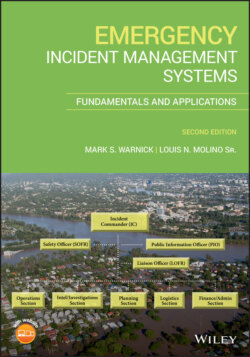Читать книгу Emergency Incident Management Systems - Mark Warnick S., Louis N. Molino Sr - Страница 58
2.5.3 Cooperation
ОглавлениеCooperation is the process of working together to accomplish a mutual goal. Cooperation requires active participation and a unity between responding agencies and entities. It creates a synergy whereby a communal effort is put forward to provide the best possible response to an incident. Cooperation is working with outside agencies in an effort to make the agency more capable of completing a task. They essentially work on the same project rather than competing against each other.
As has been stated many times, cooperation in the Tokyo sarin attack was seriously lacking. To accomplish cooperation with other agencies and entities, there must first be an open line of communication and a willingness to work together. In Tokyo, the needed cooperation and communication was nonexistent. This led to and helped to create an extremely hectic and chaotic response. Looking at the big picture, the lack of cooperation and communication led to more confusion and uncertainty about what had happened (Murakami, 2000).
Because there was not any utilization of a full‐encompassing IMS method, the response was a hodgepodge of (multiple) commanders from varying levels of government, each working toward their own goals. Even when command centers were in place, there was inefficiency, ineptitude, and ineffectiveness because of poor unit assignments that did not take advantage of each group's specialized training. Additionally, the multiple commands centers did not employ information sharing, cooperation, collaboration, and coordination, even after it was realized that it was one incident spread out over a large area.
These actions in the Tokyo incident were problematic, especially considering that a Chemical, Biological, Radiological, Nuclear, and/or Explosive (CBRNE) incident requires a mix of specialized responders. Often, specific specialized responders are needed to mitigate the agent or agents and prevent the spread of those agents to uncontaminated areas. Of course, to effectively undertake such an effort, police or some type of security force are needed to secure the area (and eventually investigate), firefighters are often needed to extricate victims and decontaminate them before letting them go or transferring them to a hospital, EMS (sometimes along with firefighters) are needed to administer prehospital care, and hospitals are needed to treat patients.
Murakami (2000) states that the death and injury toll could have been greatly reduced if the management of the incident did not have such a lethargic approach by the Tokyo government. Pangi (2002) first identified that there was no planning for such an event, and specialized training Chemical, Biological, Radiological, Nuclear, or Explosive (CBRNE) response was nonexistent at any level of government except for the military.
Information sharing was another issue. Because there was no coordination through information sharing between government entities, and relatively little information sharing between disciplines, the scope of the incident was not realized for over an hour after the attacks began. From the onset until the connection was made, each location that sarin was released was treated (by first responders) as separate incidents. According to Murakami's (2000), after completing interviews with a multitude of first responders and victims, it was found that each level of government worked independent of each other. In some instances, responders from the same level of government did not work in cooperation with their counterparts at the same level. Murakami's (2000) report stated, “There is no clear‐cut chain of command… The effort of local units were extraordinary but the overall emergency network was useless” (p. 193). He went on to say that there needed to be more integration of resources.
In Oklahoma City, cooperation was a predominant factor in having such a successful response. From the onset of the incident, numerous agencies placed their mobile command centers next to the fire departments mobile command center. While each agency had tasks related to their discipline in public safety, they cooperated and collaborated with each other to ensure that nothing was missed, and they reduced duplication of efforts. Resources from nongovernmental organizations, including nonprofits, businesses, and organizations, local governments, state governments, and the federal government cooperated to ensure a holistic response and recovery. Whenever a gap was identified, many times an agency who was qualified to fill that gap would cooperate and offer to undertake the task (ODCEM, n.d.). This led to an all‐encompassing approach that provided a superior process that sped the response and recovery process.
